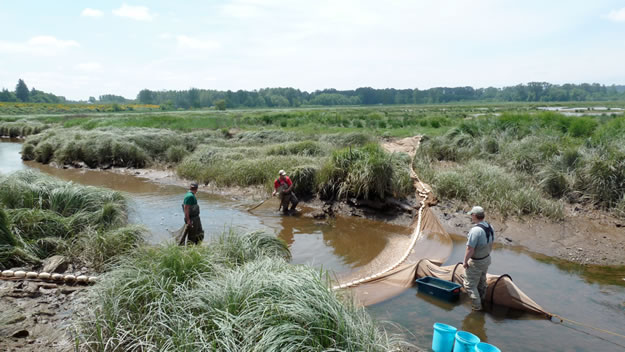Home
A rapidly growing number of tidal marsh restoration projects are ongoing or in the planning stages throughout the Western United States. Pre and post restoration monitoring are critical components of any tidal marsh restoration project to assess project outcomes, evaluate whether objectives are being achieved, to support adaptive management decisions, and investigate the implications of climate change and sea level rise. Evaluating restoration performance depends on systematic and consistent data collection as well as the development and application of proven and repeatable monitoring methods. In addition, each tidal marsh restoration project represents opportunities to advance restoration and monitoring science through the communication of lessons learned and shared experiences. By implementing a more standardized approach among restoration projects outcomes can be compared across the larger geographic scale.
This project's objective is to provide an online monitoring handbook for tidal marsh restoration practitioners "on the ground" conducting tidal marsh restoration monitoring. TidalMarshMonitoring.org offers information on tidal marsh monitoring design, selection of appropriate methods, and downloadable standard operating procedures (SOPs), datasheets and database templates, and a restoration forum for restoration practitioners, managers, scientists, and the interested public. Tidalmarshmonitoring.org is a "living" document that incorporates improved and new methods as they are developed by the restoration science community. Join the Discussion.
This project was funded by the National Wildlife Refuge System Pacific Region Inventory and Monitoring Program and the support of the U.S. Geological Survey Western Ecological Research Center, USFWS Nisqually National Wildlife Refuge, Nisqually Indian Tribe Natural Resources Department and Washington Department of Fish and Wildlife Estuary and Salmon Restoration Program (ESRP).

Habitats Covered
The monitoring methods covered in this website are focused on existing and restoring tidal marshes and channels in both estuarine and non-estuarine environments. Habitats not covered include nearshore and tidally influenced forested wetlands. More information about these habitats can be found at:
- Salish Sea Wiki
- Washington State DNR Nearshore Habitat Eelgrass Monitoring
- Brophy, L.S. (Green Point Consulting). 2009. Effectiveness Monitoring for Tidal Wetland Restoration and Reference Sites in the Siuslaw River Estuary. Prepared for Ecotrust, Portland, OR. 125pp [7.6 MB PDF]
How to use this website
If you are beginning a new monitoring program, first read about the importance of monitoring on the Why Monitor? page and then go to the Design page for detailed information on designing a monitoring plan.
Monitoring methods are grouped by three basic metrics: physical, biological, and ecological. Within each category, there are several monitoring groups such as: hydrology, sedimentation, and elevation. Each monitoring group is further broken down into categories and provides information on several methods that can be chosen based on specific project goals and on-site conditions. Downloadable SOPs, datasheets and database templates are provided for methods that we have employed on our monitoring projects. For those methods we have not used, references and links are provided to sources with more information. We also provide an extensive Reference section with downloadable references organized by topic or tidal marsh monitoring project.
Our Discussion Forum is designed to be a space to bring restoration practitioners, managers, scientists, and the interested public together to share knowledge about those "on the ground" experiences they have restoring and monitoring tidal marshes. Each website page is equipped with a Discussion Forum so that discussions are linked to the content of the page. For example, you can discuss bird monitoring methods on the Bird Monitoring Methods page, or more specifically, variable circular plot methods on the Variable Circular Plots webpage. You do not need an account to join the discussion. You can connect via Twitter, Facebook, Google+, Disqus, or simply type in your name. Updates, news, and discussion prompts about tidal marsh restoration and monitoring programs can also be found on our Facebook page.
